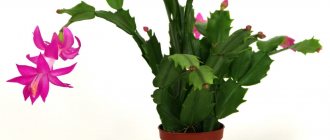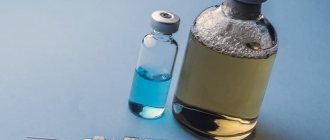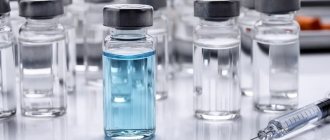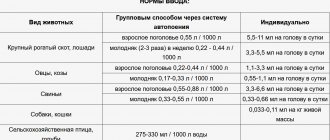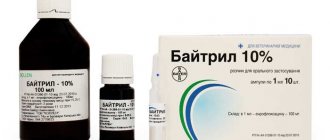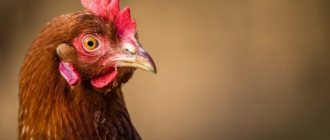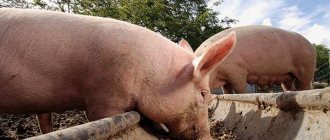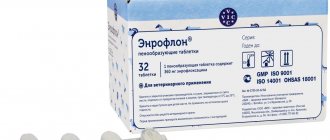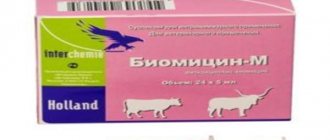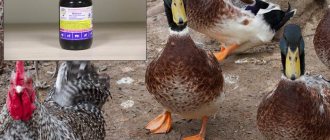At home, breeders periodically encounter diseases, the main assistants in the fight against which are antibiotics, which give a quick and strong effect. The most commonly used is Amprolium. According to doctors, it is an effective and fairly safe drug, so it is used even for breeds such as Ross, Sasso, Hubbard and others. The instructions for use of Amprolium for broiler birds provide all the necessary information on the use of the product for the treatment and prevention of coccidiosis.
For what diseases is Amprolium used?
Amprolium
The active substance of the drug affects coccidia, which significantly slows down the growth rate and can kill the protozoa. The medicine can only help against parasites of the first generations.
The product does not harm farm animals and does not impair the body’s immune defense.
Amprolium can be used against parasites that cause the following diseases:
- coccidiosis;
- eimeriosis;
- cestosis;
- trematodosis
The effectiveness of treatment and prevention depends on many factors. The main role is played by the quality of animal nutrition and living conditions. The drug belongs to the pharmacological group of coccidiostatics.
The activity of the active substance is influenced by the following features:
- temperature regime;
- quality and cleanliness of bedding materials;
- relative humidity level in the room;
- food quality and feeding frequency;
- the occurrence of concomitant diseases;
- species characteristics of parasitic microorganisms;
- the presence of active immunity in coccidia to the drug.
Instructions for use of amprolium for birds
Raising poultry is very popular for many farmers and homestead owners. To obtain high-quality results from your activities, you should implement certain preventive measures.
Coccidiosis is considered a common disease of poultry , the fight against which we will describe in this article using the drug amprolium.
The pharmacological properties and instructions for use of the drug can be found below.
Amprolium hydrochloride, which is the active substance of this drug, helps inhibit the growth of coccidiosis parasites. The drug is effective for schizogony of the first two generations . Also, it should be noted that amprolium does not have any harmful or immunosuppressive effects.
The main diseases that the drug is aimed at are:
- Coccidiosis;
- Eimeriosis;
- Cestosis;
- Trematodosis;
- Entomosis.
The success and effectiveness of the fight against coccidiosis parasites depends on the quality of feeding and maintenance of the bird. the following factors can have a certain influence on the effectiveness of any coccidiostatics :
- Temperature mode ;
- of the litter used ;
- humidity ;
- Feeding conditions ;
- The emergence of intercurrent diseases ;
- Types of coccidia ;
- Sensitivity of parasites to the drug, etc.
Consequently, the problem of the occurrence and spread of coccidiosis can be solved only with the comprehensive use of proper poultry management using amprolium, adhering to the instructions and recommended dosages.
Amprolium is applied by adding a powdered substance to feed mixture or drinking water.
For chickens
With drinking water
- For prevention purposes , it is used for poultry aged from three days to 16-17 weeks, observing a daily dose of 400-420 g of powder per 500-550 liters of water or 250 mg of hydrochloride per liter of clean water.
- Treatment - therapy is carried out for one week, adhering to daily norms - 400-420 g of powder per 500-550 liters of water or 250 mg of hydrochloride per liter of clean water. During treatment with this drug, the above-described remedy should be used as the only drink, that is, clean water should not be given to the birds.
- For the purpose of prevention , the drug is also used only for birds aged from three days to 17 weeks, in a daily dose of 400 g of the drug per ton of feed or 125 mg of amprolium hydrochloride per kilogram of feed.
How to use, dosage
Animals of different ages require different amounts of the drug. It also depends on the species, breed standards, condition of the bird and other factors.
Medicines must be used according to the attached instructions . Amprolium is produced in powder form and is added to food or drinking water.
Be sure to read:
Treatment of animals and birds with Biovit-80 for infectious diseases: instructions and price
For chickens
Dosage and method of application for chickens when mixed with water:
- For prevention at the age of 3 days to 3 months. The daily volume does not exceed 250 mg of active substance per 1 liter of water.
- For the treatment of infectious diseases. The course of therapy continues for a week, the dosage is similar to the previous one
If it is impossible to give the chicks the product with water, it is mixed with food in the following proportions:
- For preventive purposes, chickens aged from 3 days to 3 months - 400 g of the product per 1000 kg of feed or 125 mg per 1 kg.
- When treating, 850 g of Amprolium is mixed with a ton of feed, 125 mg per 1 kg. The course of treatment is from a week to 12 days.
For broiler chickens
The dosage of the drug is higher relative to other breeds.
Chicks can be given medication from the age of 3 days to 4 months:
- For prevention: 200 g of powder per half ton of water. Treatment with water: weekly course of 350 g per 500 liters of water.
- For prevention with food: 400 g per 1000 kg of feed mixture. Treatment with water – 800 g per 1 ton for 6 to 10 days.
Medicines must be used according to the attached instructions
For goslings, turkey poults and other birds
Amprolium can be given to any farm birds for preventive purposes and for therapy.
Dosage for different delivery methods:
- Adding to water. Prevention of infectious diseases - 350 g per 500 liters of water. Treatment of infestations – 400 g per half ton of water.
- With food. For prevention – 300 g per 1 ton. Treatment – 800 g per 1 ton.
For adult birds
Mature birds are allowed to add the product to their food. In this case, the total concentration should not exceed 0.1%.
Can Amprolium be given to rabbits?
In addition to poultry, the drug against coccidiosis can also be used for the treatment and prevention of diseases in rabbits (eimeriosis and entomosis).
Be sure to read:
Treatment of birds and rabbits and other animals with Baytril: instructions and price
Add 1 g of powdered substance per 1 kg of mixture or a liter of liquid to the food or water and mix thoroughly. The course of treatment lasts a week. However, it is prohibited to give animals liquid from other sources.
Preventive measures are carried out with a dosage reduced by half. The drug is mixed with food or water in a ratio of 0.5:1000. Course duration is 7-10 days.
What is Amprolium?
The drug has level 4 safety and is practically non-toxic. About 97% of the total substance is excreted in feces, the rest is digested and excreted in the urine. When used in recommended doses, it does not cause any side effects, since it is practically not absorbed into the intestines, and therefore into the bloodstream.
This effect is characterized by a similar chemical structure to thiamine. Vitamin B1 is an extremely important component of the life and reproduction of coccidia.
Due to the similarity, the drug penetrates the parasitic cell. Then it takes up space inside intended for the absorption of vitamins and disrupts the metabolism in bacteria, as a result of which the parasitic infection dies.
For what diseases is amprolium used?
The main effectiveness is against coccidia bacteria. Harmful microorganisms are destroyed, while the immune system is not suppressed, and the animals’ recovery is achieved fairly quickly. The drug is effective against 1st and 2nd generation schizogony.
The main diseases with vulnerability to amprolium:
- Coccidiosis;
- Trematodosis;
- Entomosis;
- Cestosis;
- Eimeriosis.
Coccidiosis is a serious disease that primarily affects the digestive system. Micronutrients from foods are not absorbed.
It is also accompanied by dehydration and can provoke blood loss. The body's immunity is greatly suppressed, which in turn increases the risk of infection and other serious diseases. In the absence or improper treatment, death occurs.
It is difficult to eliminate a disease based on the use of medication alone. Other important treatment factors are living conditions and feeding. So important factors for recovery are:
- Moderate temperature;
- Condition and quality of litter;
- Humidity level;
- Diet;
- Coccidia type;
- Presence of intercurrent diseases.
Complex treatment allows you to achieve maximum results from treatment.
Instructions for use of amprolium
Amprolium is excellent for treating coccidia not only in rabbits, but also in birds or sheep. The drug can be used for prophylactic purposes or direct treatment. The medicine comes in the form of a white powder. It is used in one of several ways: dissolved in water or added to food.
The effectiveness of treatment largely depends on the factors in the rabbits’ environment, so creating a favorable environment is half the treatment.
Preliminary actions before use:
- Separate sick animals from healthy ones. Place them in different cells and place them at a certain distance from each other;
- All foreign elements in the cage should be removed. First of all, feces, since coccidiosis actively spreads through feces, from where it enters the air and can infect healthy individuals. Also remove food debris, debris and other unwanted substances;
- It is better to clean the cage of bacteria using boiling water or a burner;
- The entire water source: the reservoir, bowls and drinking bowls must be cleaned, preferably using a disinfectant;
- Temperature conditions and high humidity further weaken the rabbit. Thus, the already weak immunity is suppressed;
- When keeping several types of animals in one place, it is better to separate them. Particularly dangerous can be birds and sheep, which are also prone to coccidia.
Using the drug with water:
- It is necessary to prepare a container for water that will be sufficient for all rabbits;
- Add 1 g of treatment drug to it for each liter;
- Mix the composition thoroughly;
- If there is no self-supply system for water, then the mixture should be poured manually;
- Number of uses per day - it is necessary to regularly replenish the drinking bowls with water and medication.
An alternative method of use is mixing with food. Hay, root vegetables, grain crops, and concentrates are usually used as food.
- Take dry food for all rabbits and place in a container;
- Add amprolium, use 1 g for every 1 kg;
- Mixed and distributed to animals.
It should be noted that the treatment was now being prepared for rabbits. Having separated the healthy and the sick before the procedure, you need to take care of both groups. For patients, treatment is described above, but for healthy people, only prevention is necessary.
Thus, the procedure will not differ except for the proportion of the drug, but you will have to mix food or water separately for both groups. A preventive measure involves the use of 0.5 g of the drug per 1 liter of water or 1 kg of feed.
Important! After treatment, the rabbit cannot be slaughtered for 14 days, otherwise the meat will not be suitable for consumption. If slaughtered during this period, the meat can be fed to carnivores.
The advantage of this method is that regardless of age, and rabbits are usually sick for 1.5 - 3 months, the medicinal dosage will be determined by the amount of water drunk or food eaten. Thus, the drug content is always normal and only in rare cases the dose is increased slightly.
Contraindications for use
The drug does not cause side effects, there are no mentions of such cases, but some contraindications still exist:
- Intolerance or hypersensitivity to the drug;
- Diseases associated with difficulty passing feces and urine, especially kidney and liver diseases;
- When replacement young animals have reached 16 weeks of age or more;
- Particular caution is required when using furan group drugs with antibiotics or anticoxidiotics.
An overdose study showed the safety of the drug, the only side effect being a slowdown in rabbit growth.
All about drugs for coccidiosis in rabbits
There are other effective anti-oxidative drugs, since amprolium is not always quickly available within a village or small town. Tulocox, Baytril, Eimeterm, Zinaprim can serve as high-quality and worthy replacements.
Eimetherm
Eimeterm is a drug that belongs to a number of antibiotics with a wide spectrum of effects.
Contraindications for use
If the dose was exceeded, the growth rate of birds decreased slightly.
It is not advisable to give the drug to replacement young animals, individuals older than 3 months, and laying hens. Before slaughter, it is advisable to keep the bird for a week without using the product.
Rabbits should not be given Amprolium in the following cases:
- Age up to 16 weeks.
- Disorders of the urinary and digestive systems. In this case, the removal of active substances from the body becomes much more difficult.
- If animals are already receiving other medications aimed at inhibiting the development of coccidia.
Side effects and contraindications
According to GOST, the drug is classified as low-toxic, therefore, if the drug is used correctly, side effects do not occur. In rare cases, individual intolerance is possible in a small number of birds - less than 5%, as well as a slight weight loss after the course of treatment.
Veterinarians do not recommend giving Amprolium to the following categories of birds:
- replacement young stock aged from 16 weeks;
- laying hens.
If the dosage is exceeded, birds may develop polyneuritis.
Pharmacological properties
Main properties and effect of the drug:
- Active against various types of coccidia.
- It works better than thiamine (vitamin B1), so it penetrates the parasite cell faster, disrupting carbohydrate metabolism. As a result, the life activity of bacteria slows down significantly, and the bacterium dies.
- Non-toxic when used in therapeutic doses
- It is almost completely eliminated from the animal’s body in a short time.
- Forms active immunity, which prevents further infection.
Be sure to read:
Top 6 metronidazole analogues: list of substitutes
Pharmacology of the drug and composition
The veterinary drug Amprolium is an anticoccidial agent for birds and livestock. It looks like a light or yellowish powder. The medicine is sold in plastic bags or plastic containers of various sizes.
1 g of powder contains 300 mg of amprolium hydrochloride. In addition, the drug contains an auxiliary component - lactose. In veterinary medicine it is used to treat poultry and farm animals from diseases caused by coccidia.
The active component of the drug is close in structure to thiamine, a substance that coccidia require for reproduction. After using the drug, amprolium hydrochloride replaces thiamine, which causes disturbances in carbohydrate metabolism in parasites and their death.
The use of small doses of Amprolium to prevent infection does not have a negative effect on birds, therefore the product is recognized as low-toxic.
About 97% of the medicine is excreted from the body of birds along with feces.
Special instructions, storage, price
All actions with the powdered drug are carried out in protective equipment. While mixing, do not eat or drink any liquids or smoke. After completing the preparations, it is advisable to take a swim.
Slaughter of poultry for meat is permitted 5 days after cessation of antibiotic use. If the slaughter occurred earlier, then such meat can be fed to animals or used to make meat and bone meal.
Store the drug in a dry place, protected from light, at a temperature not exceeding +30 degrees. Shelf life: 2 years.
Terms and conditions of storage
Manufacturers recommend storing Amprolium in a dry place, out of reach of children, pets and sunlight. Storage temperature - up to 25 ℃. Do not keep the medicine near food, drinks or animal feed. The product can be used within two years from the date of production. If the drug was diluted in water, then the solution should be used within 24 hours. The medicine mixed with dry food can be stored for a week.
Amprolium is an effective and harmless drug for birds that helps strengthen the immune system, is not addictive and effectively fights coccidiosis. When using the product, you must strictly follow the instructions, adhere to the recommendations and take precautions.
What other analogues exist?
In addition to Amprolium, it is possible to use other medications to treat invasive diseases of birds and rabbits:
- Eimeterm is a suspension with a coccidiostatic effect. The active substance is toltrazuril.
- Baytril is a broad-spectrum antimicrobial agent. Effective against coccidiosis. Available in the form of a solution with different concentrations.
- Zinaprim is a solution for intramuscular injection. The active ingredients are sulfamethazine and trimethoprim. The components mutually reinforce each other.
Key Caveats
All medications have their own characteristics.
Amprolium is no exception:
- Modern veterinary medicine does not recommend using this product for laying hens and young animals older than 15 weeks, as it easily gets into the eggs. In this case, undesirable consequences for humans are possible. Simultaneous use with other drugs of similar effect is not allowed.
- Poultry can be slaughtered a week after the last day of adding Amprolium to water or food. Early slaughter is dangerous, since the active substance does not have time to completely leave the body.
- It can be used together with vitamin complexes and special feed additives. Doctors recommend increasing the amount of vegetables, grains and minerals for birds during treatment.
Application and dosage
- For broilers, for the purpose of prevention, give from 3-5 days of age in a mixture with feed or water, at a dosage of 480 g/1 t of feed or water; for medicinal purposes - for 7-10 days - 960 g / 1 t of feed or water.
- For replacement young birds for the purpose of prevention at 3-5 days of age up to 16 weeks of age - 480 g / 1 t of feed; for medicinal purposes - for 7-10 days - 960 g / 1 t of feed. With water for the purpose of prevention - from 3-5 days of age to 21 days of life - 240 g / 500 l of water; for medicinal purposes - for 5-7 days - 480 g / 500 l of water. During the period of treatment and prophylaxis, the solution with the drug should be the only source of drink.
- For young cattle and sheep: for treatment - 0.04 g/1 kg of body weight, 1 time per day, for 5 days, in severe cases the dose of the drug should be doubled; for the purpose of prevention - for young cattle - 0.028 g/1 kg of weight, for 21 days; sheep - 0.028 g/1 kg of weight, for 5 days.
The drug can be given to animals with drinking water, drink, or milk replacer. To do this, 28 g of the drug is dissolved in 300 ml of water or other liquid food. When used with mixed feed, it is necessary to mix 28 grams of the drug with one kg of compound feed and administer it orally at the rate of 5 grams of the mixture per kg of animal daily for 4-5 days.
Indications and effectiveness
Veterinarians recommend using Amprolium to eliminate the following diseases:
- coccidiosis;
- eimeriosis;
- trematodosis;
- cestodosis
The effectiveness of the medicine in treating poultry depends on certain factors:
- thermal conditions and humidity levels in the room where the birds live;
- conditions of detention, cleanliness, diet.
The effectiveness of the drug can be affected by the type of coccidia and their susceptibility to the active component, the presence of other infections and pathologies.
Broiler chicken mixtures
To prevent coccidiosis, it is necessary to give 120 mg of powder combined with 1.2 liters. This amount can be diluted in a teaspoon, and then added to the rest of the liquid. Two hundred thirty grams is calculated for 490 liters.
A week before slaughter, prophylaxis is stopped. A mixture will help get rid of coccidiosis: 220 mg of the drug combined with 950 ml of water, and 360 g of powder with 510 liters. Amprolium for broilers is effective; if the dosage is observed, it will not disrupt the growth of the bird.
Amprolium 25 is mixed into the feed. For broilers aged 4 days to 4 months, a dosage of 100 mg per 900 g of food is recommended. Treatment is carried out for 8 days. Seven hundred grams for 9 centners of food. Amprolium for broiler chickens is given at 100 mg, mixed with 900 g of food.
Veterinary first aid kit for chickens
Articles and recommendations
Simultaneously with the appearance of chickens on your farm, you must buy a veterinary first aid kit - the main assistant in protecting young poultry from infectious diseases and for maintaining the energy balance of the poultry body in the future.
Such a veterinary first aid kit for chickens should contain drugs for the treatment and prevention of infectious diseases, means to increase the body's defenses, vitamins, and means for the treatment and prevention of coccidiosis.
Particularly close observation will be necessary for chickens in the first weeks of life. Considering that at this time their immunity is especially weak, they must be additionally given special vitamin or prophylactic solutions. This is where a veterinary first aid kit for chickens comes in handy.
First aid kits are equipped with the following necessary medications.
Norfloxacin (10%)
It is a highly effective antibacterial agent for the treatment and prevention of infectious diseases of birds (colibacillosis, salmonellosis, pasteurellosis, mycoplasmosis, necrotic enteritis, streptococcosis, hemophilia, and other diseases of infectious etiology.).
They need to feed newborn chicks for three days. To prepare the solution, pour the contents of one ampoule of Norfloxacin into one liter of drinking water and mix thoroughly
It is important to remember that the Norfloxacin solution must be freshly prepared. Duration of treatment for chickens: 3-5 days
Vitamin C
Your chicken first aid kit should also include ascorbic acid (vitamin C). It is designed to increase the overall tone and defenses of the animal’s body. Vitamin C also enhances the processes of fermentation and digestion in the intestines. To prepare the solution, you need to dissolve the contents of a bag of ascorbic acid in three liters of drinking water at room temperature. It is recommended to divide the resulting solution into three equal parts (one liter each) and feed the chickens one liter per day for three days.
Chiktonik
Another essential component of a chicken's first aid kit. Chiktonik is used for the treatment and prevention of metabolic disorders, hypovitaminosis and vitamin deficiencies, as well as in stressful conditions of poultry.
This element of a chicken first aid kit can be used for animals no earlier than seven days after their birth. One milliliter of Chiktonik should be dissolved in one liter of drinking water at room temperature and the chickens should be fed the resulting solution for 5-7 days. The solution must be freshly prepared.
Biovit
A fairly important component of a chicken's first aid kit is Biovit, a feed antibiotic that contains B vitamins, incl. important vitamin B12 and chlortetracycline. Biovit is a well-known growth stimulator of young poultry and an effective means of preventing hypovitaminosis and infectious diseases. Biovit is used for the prevention and treatment of coccidiosis, pullorosis, colisepticemia, cholera, mycoplasmosis, laryngotracheitis and ornithosis in poultry.
Biovit can be used from 7-8 days of chicken life
It is important to remember that Biovit cannot be used together with Norfloxacin. It is recommended to give Biovit for therapeutic purposes 2 times a day for 4-5 days and another 3 days after the disappearance of clinical symptoms. For prevention, Biovit is fed to chickens once a day for 5-20 days in doses of 0.41 g per animal
It is strictly forbidden to add Biovit to hot food.
For prevention, Biovit is fed to chickens once a day for 5-20 days in doses of 0.41 g per animal. It is strictly forbidden to add Biovit to hot food.
Baykotsid-K
A veterinary first aid kit for chickens should contain a coccidiostat. Baikocid-K is a highly effective drug for the prevention and treatment of coccidiosis of all types of poultry. It can be used together with vitamins for chickens, feed additives and other medicinal preparations for birds.
The contents of 1 ampoule (1 ml) are dissolved in 1 liter of water. Drink for 2 days. In case of severe infection, repeat the course of treatment after 5 days. The solution can be fed from 14 days of age.
Indications for use
Tetrahydrovit for broilers and chickens has a fairly wide range of applications. Among the most significant indications are the following:
- Preparing poultry for transportation.
- If it is necessary to replace feed during fattening.
- If birds are gaining weight slowly.
- Hypovitaminosis.
- As a support for the body during vaccination and deworming.
- In case of infection of livestock with infectious and invasive diseases.
- With low egg production in laying hens.
- To increase the strength of egg shells.
Broiler chickens
Tetragidrovit acts quickly and effectively and is capable of completely replenishing the deficiency of the following vitamins in the body of birds:
- Vitamin A. Restores the structure and functioning of epithelial cells, strengthens the immune system.
- D3. Normalizes the process of calcium and phosphorus metabolism in the body. Prevents the development of rickets.
- E. Has a positive effect on the course of redox processes in birds.
- C. Strengthens the immunity of broilers and chickens, providing resistance to infection by all types of diseases.
The use of the drug guarantees the accumulation of vitamins in liver cells and other tissues.
Important! Broiler and chicken meat does not accumulate this drug. Meat products and eggs are completely suitable for consumption and safe


